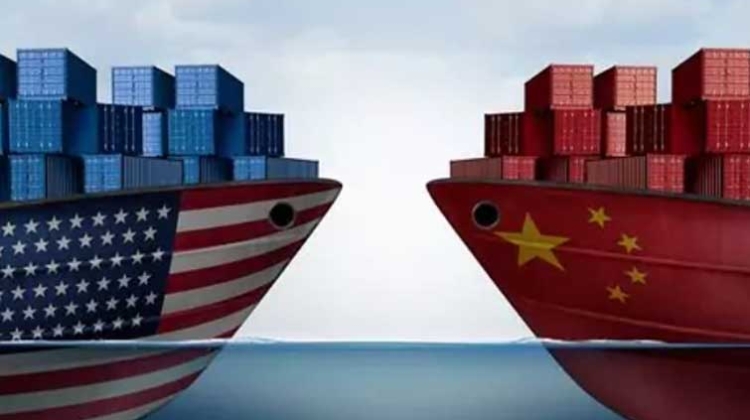Trump Takes on a Globalist Trading System Rigged Against the U.S.
Other nations use non-tariff trade barriers as weapons to choke off American exports.

|
Getting your Trinity Audio player ready...
|
[Want even more content from FPM? Sign up for FPM+ to unlock exclusive series, virtual town-halls with our authors, and more—now for just $3.99/month. Click here to sign up.]
For decades, U.S. presidents and congressional leaders from both parties rolled over and accepted global trading arrangements that have put the United States at a great disadvantage. The result is that the United States had a $1.2 trillion goods trade deficit in 2024, the largest of which has been with China.
A fact sheet issued by the White House on April 2nd explains the stakes in what amounts to other countries’ economic attacks on America: “Large and persistent annual U.S. goods trade deficits have led to the hollowing out of our manufacturing base; resulted in a lack of incentive to increase advanced domestic manufacturing capacity; undermined critical supply chains; and rendered our defense-industrial base dependent on foreign adversaries.”
President Trump has decided that enough is enough. He is using America’s enormous leverage to pressure its trading partners to ditch their unfair trade barriers and level the playing field. The White House fact sheet calls this “the golden rule on trade: Treat us like we treat you.”
America’s trading partners have imposed tariffs on U.S. goods imported into their countries that are far steeper than the tariffs that the U.S. has imposed on their goods. Even more insidiously, America’s trading partners have erected high non-tariff trade barriers that stifle U.S. companies’ access to their markets. These countries also flood the U.S.’s far more open markets with goods at prices subsidized by foreign governments that American companies cannot compete with.
The 397-page 2025 National Trade Estimate Report on Foreign Trade Barriers (2025 Foreign Trade Barriers Report) lists examples of such non-tariff trade barriers. They include:
1. Technical barriers such as “unnecessarily trade restrictive standards;”
2. Sanitary requirements that “unnecessarily restrict trade without furthering safety objectives;”
3. Services barriers such as “prohibitions or restrictions on foreign participation in the market, discriminatory licensing requirements or regulatory standards;”
4. Investment barriers such as “technology transfer requirements” and inadequate enforcement of intellectual property rights;
5. Anticompetitive practices such as “government-tolerated anticompetitive conduct of state-owned or private firms that restricts the sale or purchase of U.S. goods or services in the foreign country’s markets or abuse of competition laws to inhibit trade;” and
6. Unfair advantages for state-owned companies including subsidies and other benefits that “discriminate against U.S. goods or services.”
The 2025 Foreign Trade Barriers Report discusses “the largest export markets for the United States, covering nearly 60 trading partners.” This article focuses on two of the most significant markets, China and the European Union, to illustrate how foe and friend alike use non-tariff trade barriers unfairly to impede U.S. exporters’ access to their markets.
CHINA
China is the global leader in erecting high non-tariff barriers to foreign companies seeking to enter its markets. Ever since China joined the World Trade Organization in 2001, the Chinese Communist regime has gamed the global trading system to give itself an unfair competitive advantage. The regime has designed and manipulated its standards, licensing, product registration, intellectual property, and anti-monopoly regulatory systems to cheat its way to becoming an economic powerhouse at America’s expense.
For example, U.S. agricultural exporters have encountered regulatory measures that are not based “on science-based risk assessment or international standards,” according to the 2025 Foreign Trade Barriers Report, along with regulatory enforcement that is neither transparent nor rules-based.
In the cosmetics field, according to the 2025 Foreign Trade Barriers Report, China’s filing and registration requirements “significantly diverge from those in other major markets without adequate justification, making compliance very burdensome for exporters.” Moreover, “China continues to require duplicative in-country testing to assess many product and ingredient safety and performance claims” while virtually ignoring “the applicability of testing conducted via internationally recognized laboratories outside of China…”
In the service sector, the 2025 Foreign Trade Barriers Report explains, Chinese regulators continue to use “discriminatory regulatory processes, informal bans on entry and expansion, case-by-case approvals in some services sectors, overly burdensome licensing and operating requirements, and other means to frustrate the efforts of U.S. suppliers of services to achieve their full market potential in China.” The services impacted by these overly burdensome restrictions include cloud computing, telecommunications, film production and distribution, and online video and entertainment services.
Aside from its outright theft of intellectual property, China has pressured American companies to transfer technologies, sensitive data, and intellectual property to Chinese entities as a condition to obtain access for trade and investments in China’s markets.
China has also weaponized its so-called Anti-Monopoly Law against foreign companies that seek to do business in China, while propping up state-owned monopolies with massive government subsidies.
EUROPEAN UNION (EU)
Despite significant trade and investment flows between the U.S. and the EU, merchandise and services “produced by the United States nonetheless face persistent barriers entering and maintaining access to certain sectors of the EU market,” according to the 2025 Foreign Trade Barriers Report.
The EU takes an exclusionary approach, for example, by requiring exporters’ products to strictly conform with European-specific regional standards developed by a recognized European Standards Organization to demonstrate compliance with relevant EU legislation. The fact that the exporters’ products comply with international standards at least as stringent as the EU’s core requirements is meaningless to EU regulators.
The EU has also imposed unnecessarily burdensome bans and restrictions on the import of certain meats into the EU market. “Despite scientific evidence that such meat is safe for consumers, the EU maintains various measures that impose bans and restrictions on meat produced using hormones, beta agonists, and other growth promotants approved for use in the United States,” according to the 2025 Foreign Trade Barriers Report.
U.S. producers must “participate in a costly and burdensome verification program to ensure that hormones, beta agonists, or other growth promotants have not been used in their production” if they want to export meat or meat products to the EU.
While an agreement has been reached between the U.S. and the EU to provide American ranchers with a duty-free tariff-rate quota that rises annually over seven years, the EU’s restrictive residue monitoring program for animal products remains.
The ostensible purpose of the EU’s Digital Services Act (DSA), which took effect in February 2024, is to protect against so-called “misinformation,” “disinformation,” and “hate speech” online. It is particularly aimed at large digital services suppliers designated as “Very Large Online Platforms,” the majority of which just so happen to be the major U.S. digital platform companies such as Google, Meta, and X. The DSA, as implemented by the EU Commission, puts these U.S. companies into a corner. To do business in EU member countries, they must either enforce the EU’s censorship-laden speech code, which is inconsistent with the U.S. Constitution’s First Amendment, or face stiff penalties. This results, as the 2025 Foreign Trade Barriers Report observes, in “regulatory burdens that disproportionately affect U.S. firms.”
China and the EU are far from alone in erecting unfair non-tariff trade barriers that impede American exporters’ access to their markets, which are far more onerous than any such barriers their exporters face in accessing U.S. markets.
Both the United Kingdom and South Africa, for example, maintain non-science-based standards that severely restrict U.S. exports of safe, high-quality meat and poultry products.
India imposes “burdensome and/or duplicative testing and certification requirements in sectors such as chemicals, telecom products, and medical devices,” according to the White House fact sheet, “that make it difficult or costly for American companies to sell their products in India.”
U.S. auto companies seeking to sell their cars in Japan face non-tariff trade barriers that restrict their access to Japan’s automobile market.
Canada enacted a digital services tax on online service providers above specified revenue thresholds that discriminates against American vis-a-vis Canadian firms in similar lines of business.
The 2025 Foreign Trade Barriers Report provides many more examples of non-tariff trade barriers in large export markets that block U.S. producers from gaining full access to those markets.
While the impact of tariffs on U.S. exports can be quantified, the scope and variety of non-tariff trade barriers are too opaque and changeable to measure their effect in creating the huge existing trade imbalances with any precision. Thus, in calculating the reciprocal tariffs to correct trade imbalances with other countries caused by both tariffs and non-tariff trade barriers, the Trump administration devised a simple formula: divide a country’s trade deficit by the value of imports from that country and then divide that quotient by two to calculate the reciprocal tariff rate.
During the last three decades many thousands of plants and factories have closed in the United States and about five million Americans have lost their good paying manufacturing jobs. U.S. politicians have allowed this to happen by letting America’s opportunistic trading partners to gain the upper hand on an unlevel playing field.
No more. As the April 2nd White House fact sheet stated: “The United States will no longer put itself last on matters of international trade in exchange for empty promises.”
President Trump is open to negotiating fair, mutually beneficial trade deals with willing trading partners. But if China and other recalcitrant countries choose the path of retaliation and ratchet up their attacks on America’s economy, they will be dealing with a U.S. president determined to “fight, fight, fight” to protect the American people.

